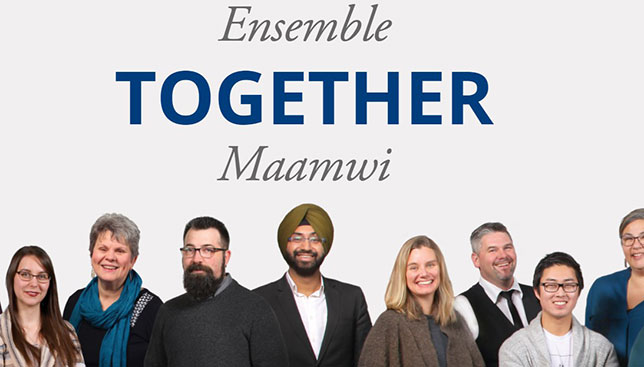Elections are an important time for getting the message out, and not just for those who are running. As he shook hands with one candidate after another in the lead-up to the Quebec election last October, Université de Sherbrooke rector Pierre Cossette had a handy tool that made it easy to communicate his university’s message to those who might soon have a say over its financial future. The university’s strategic direction over the next five years, approved in March 2018, was neatly crystallized in a two-page, double-sided brochure entitled “Oser transformer” (dare to transform).
It was the university’s new strategic plan, encapsulating six months of development and consultations with more than 5,000 people on campus and off, as well as previous work on its mission and values statements. With four broad priorities and 22 related strategies, the succinct document “made it easy for the candidates to understand where we want to go,” says Dr. Cossette. “It’s a sort of calling card.”
Once only the purview of the military and for-profit corporations, strategic plans have grown to become commonplace at universities over the last 30 years, showing up not only at the top level, but within individual faculties, colleges and programs, too. “A strategic plan is meant to help guide any organization in terms of the choices that it makes for resource allocation,” says Sarah Kaplan, a strategic management professor at the University of Toronto’s Rotman School of Management.
Universities have always planned, but unreliable funding, increasing accountability demands and greater competition for students and top faculty have pushed Canadian universities to adopt a similar practice to that used by businesses to determine what their priorities should be for the deployment of scarce resources. And, as Dr. Cossette’s example shows, the university strategic plan is as much a tool for attracting funding and other forms of support as it is for determining how current resources should be used.
“We are constantly sending it out,” says Peter Stoicheff, president of the University of Saskatchewan, of his university’s latest strategic plan (its fourth), called “The University the World Needs.” A strategic plan allows a university to “communicate succinctly” to stakeholders such as governments, donors and alumni “what you’re all about and where you’re intending to go with their support,” says Dr. Stoicheff. It’s also important for staking out an identity and using that to recruit and retain students and faculty in a competitive sea of other universities worldwide.
Strategic planning at universities is “a huge global trend,” says Elizabeth Buckner, an assistant professor with a specialty in the privatization of higher education at the Ontario Institute for Studies in Education of the University of Toronto. She traces their origin to the shift in universities being regarded as places guided largely by academic governance to ones that are “organizations like any other,” encouraged to be entrepreneurial and with similar management practices. While strategic plans address the use of resources, Dr. Buckner says they are also “symbolic” as “artifacts of how universities articulate their values.”
In its 2018-2023 plan, called “Together” (also expressed as “Ensemble” and “Maamwi” in French and Ojibwa), Laurentian University in Sudbury, Ontario, intends to develop graduates who will become “employees of choice” in northern communities and industries, and act as “champions of French culture and language.” Both goals are related to “the North inspires us,” one of the plan’s five values. U de Sherbrooke’s Dr. Cossette, meanwhile, says his university’s value of innovation and “venturing off the beaten path,” has already inspired staff to choose a more ambitious architectural design than they otherwise might have for the institution’s new Quantum Institute building.
If this article has already shown more enthusiasm for strategic plans than you’ve ever felt for them yourself, most planners are keenly aware of their potential for generating skepticism and indifference – even Dr. Cossette says he regarded them as “a necessary evil” before he entered senior leadership. Engaging people’s interest in the strategic plan can admittedly be an uphill battle, especially since faculty may identify more with their discipline and research over the institution at large.
At Laurentian, there used to be “a shared cynicism about strategic planning. You write these grandiose things, you put them on the shelf, [and] nobody ever looks at them again,” says history professor Linda Ambrose, who served as a special advisor to the president for the university’s most recent plan.
Overcoming that challenge requires broad consultation and identifying common ground between internal interests and external demands. Done well, it can build a stronger sense of shared purpose. “The most successful pieces of a strategic plan are where you get traction between those ideas that are coming up from faculty, staff and students, and where they tie in with what the institutional priorities of a university are,” says Peter Ricketts, president of Acadia University.
Acadia started working on its first strategic plan in 13 years in March 2018, beginning with online submissions and town halls with the university community, then using the ideas that were shared to identify themes through a more focused task force. The new plan is expected to be finalized by this June. The previous plan was developed using external consultants and was somewhat “divisive,” says Dr. Ricketts, partly because it was perceived as too top-down. As a result, it was “never really implemented” and was overwhelmed when the university hit a financial crisis not long after.
Attitudes at Laurentian shifted in the last strategic plan under former president Dominic Giroux, which covered 2012 to 2017, when people realized it would have a big influence on funding. “He said, ‘We don’t plan a budget. We budget the plan,’” recalls Dr. Ambrose. The university counts the doubling of research funding and a substantial increase in Indigenous faculty among the plan’s successes. But, at the time, some social sciences and humanities professors complained that their departments were left under-resourced, because the plan didn’t recognize theirs as flagship programs. No surprise that this time around people made a point of inviting Dr. Ambrose to their meetings so they could make sure their ideas were heard. “When people actually see themselves invested in the plan – that makes all the difference,” she says.
Students were involved in virtually every stage of the development of the University of British Columbia’s strategic plan, called “Shaping UBC’s Next Century,” released last year. Max Holmes, vice-president of academic and university affairs for UBC’s Alma Mater Society, calls that scenario “ideal” and one that led to the inclusion of important student priorities, such as educational affordability and addressing sexual violence. The third-year arts student says strategic plans make the university’s commitments transparent and help ensure that those priorities have staying power beyond a few short years. “[Students] can make an argument that you should fund this student priority because it’s within your strategic plan – you have said that you are going to do this,” says Mr. Holmes.
Benefits aside, strategic planning has been criticized for applying a business model to an entity that is very different from one whose main concern is turning a profit. “Universities are complicated social institutions that have a lot of different outcomes and a lot of different stakeholders,” OISE’s Dr. Buckner notes.
But planning advocates argue it is that complexity that requires thoughtful consideration of how to support the whole enterprise and still meet fresh expectations. And while public universities are not for-profit businesses, they face comparable challenges. The people for whom they are creating value – their customers – are stakeholders such as students, taxpayers, donors and government. Universities compete too, says Dr. Kaplan – against other universities for students, against other government spending demands and against other charities for donor funds. A strategic plan is a vehicle for universities to sell their mission and show stakeholders how the institution will deliver on it and its values.
That requires listening carefully not only to what a university’s internal stakeholders want, but also to the values and preoccupations of those outside the university – all the while being able to respond to other opportunities, threats and trends. Strategic plans make universities “change ready,” says Nicholas Santilli, who teaches postsecondary institutions how to plan as lead facilitator for the U.S.-based Society of College and University Planners. In one example, he points to the need for universities to prepare for “Generation Z,” the group coming up behind millennials, who may have different learning needs and expectations. Adults eager to complete credentials or get new ones to stay job-competitive are another opportunity. “Planning is about change,” says Dr. Santilli. “You don’t plan for the status quo.”
In tune with that, more university strategic plans are demonstrating a greater focus on local community needs, such as working towards reconciliation with Indigenous peoples. The University of Saskatchewan has Indigeneity woven through each of its three strategic commitments, using an Indigenous-themed “weave” to represent the plan in a single illustration.
The University of Victoria, which made local and global engagement a priority in its 2018-2022 strategic plan, has set a related goal of improving community access to the university and ensuring it’s welcoming and culturally aware. Laurentian took its consultations off-site to six venues, meeting with Indigenous educators on Manitoulin Island, with schoolchildren in Sudbury, and with community members in the small mining community of Cobalt, Ontario, who were concerned about how the university could help stem youth outmigration. “They need us to succeed so that their youth succeed,” says Dr. Ambrose. Internationalization, innovation, experiential learning, equity and diversity, as well as collaboration and interdisciplinarity are other broad priorities that frequently show up in strategic plans.
Where plans tend to fail is in their implementation. Planners may neglect to fully think through how their plans will be resourced. “I say all the time to my students, ‘It’s not a strategy if you don’t allocate resources to it,’ ” says Dr. Kaplan.
As well, goals may need more time to be implemented than over the life of one plan. The University of Saskatchewan didn’t achieve all of its 2012-2017 goals for greater engagement with Indigenous students, scholarship and programs, and has gone with a seven-year plan this time around. Planners may neglect to consult with the right people to verify whether a goal is realistic – information technology infrastructure to support a technology-reliant goal, for example – and may struggle with identifying goals people care about that can be implemented in measurable ways. A rise in external rankings is a common goal and certainly measurable, but not necessarily one everyone in the university supports.
If a plan has any hope of being meaningful to anyone beyond upper administration, it must tell a story compelling enough to motivate people to support its implementation. “The craft of these things is in the narrative, it’s not in the task list,” says Alex Usher, president of Toronto-based consulting firm Higher Education Strategy Associates. “It has to speak to them about the kind of institution they’re in, the kind of institution they want to be.” Like the anecdote about the 1960s-era NASA caretaker who said his job was helping to get a man on the moon, a strategic plan must be concise enough for members of the university to easily understand what part they play in it. Strategic plans “don’t do enough of that,” says Mr. Usher. “There’s [still] a lot of list-making.”
While university presidents may be tempted to see a strategic plan as their own, those interviewed for this story said a plan should reflect how the university community, writ large, sees its direction and be capable of surviving past a single president’s term. Having one in place when a new president is hired can actually be “a gift,” says Dr. Ambrose, because it gives that person time to get acquainted with their new environment before considering changes.
How does anyone know whether a plan is being translated into concrete action? Some universities require or encourage their sub-units – colleges, schools, faculties – to design their own plans once the larger one is done, to prime the pump for on-the-ground execution. Some have planning offices to track what’s happening. University presidents typically report progress on the strategic plan to their boards. Laurentian has set up an “Outcome 26 Group” of administrators and deans to track progress on its plan’s 25 goals and is using the strategic plan’s hashtag – #imagine2023 – to track and log their progress via social media.
As universities get more accustomed to the process, plans seem to be getting better. Even Mr. Usher, who feels most universities still need work on doing them well, is seeing fewer “cookie cutter” plans than he did 10 years ago. For those who remain skeptical, university communities should not dismiss the opportunity that strategic planning provides for them to speak up about the role their university plays in advancing society and the culture, says Dr. Santilli. “We’ve lost that voice, and others have taken it upon themselves to say what we should be, whether they’re politicians or businesses,” he says. Part of it is that we haven’t been saying very well the part we do play.”




